Post-COVID life—the way consumers live, learn, work, and play—is unlikely to ever return to the old “normal.” For example, international consulting firm Telecom Advisory Services estimates that 54% of the workforce will be hybrid, working from home at least part of the time. The pandemic also accelerated digital transformation for many businesses, and consumers will not be giving up on the newfound digital experiences that resulted from that transformation.
These tech trends are taking hold just as WiFi 6 builds momentum in the market. Capable of supporting more advanced, bandwidth-intensive use cases such as virtual reality (VR) and augmented reality (AR), WiFi 6 is expected to bring drastic changes, both for consumers and enterprises. While this is exciting, it also presents a challenge for CSPs because they need to ensure their service delivery can support these use cases without adversely affecting the quality of experience for subscribers.
The pandemic already began altering the WiFi connectivity landscape. But the combination of three factors—the changing consumer behaviors, WiFi 6 adoption, and the expectation that regulators will allocate more WiFi spectrum—has the potential to elevate the role of WiFi to levels never seen before. And CSPs need to be ready.
Capable of supporting more advanced, bandwidth-intensive use cases such as virtual reality (VR) and augmented reality (AR), WiFi 6 is expected to bring drastic changes, both for consumers and enterprises.
The combination of these three factors has the potential to elevate the role of WiFi to levels never seen before
WiFi-powered innovation and future tech trends
Some of the potential of the new WiFi technology hinges on access to the 1200 MHz and 6 GHz band (WiFi 6E). Many countries have already made great strides in that direction. The US, for example, approved the 6 GHz spectrum to unlicensed WiFi in April 2020 (in what some have called a historic and monumental decision)—and by December 2020, FCC had already authorized the first WiFi 6E device.
April 2020
The US approved the 6 GHz spectrum to unlicensed WiFi
December 2020
FCC authorized the first WiFi 6E device
While these developments are still in the early stages, the 6 GHz spectrum and future WiFi generations will deliver another wave of AR/VR innovation, IoT expansion, increase in video streaming, and more.
One trend that CSPs should be preparing for right now is the self-optimizing, adaptive home of the future. Simply having smart home conveniences is no longer satisfying for consumers. In the near future, consumers of all ages will be expecting a truly smart home—one that learns from their living patterns and behaviors and adapts to their lifestyles.
As another example, consider the metaverse, one of the hottest ideas that’s making its way from enthusiastic consumer discussions into the business space. A virtual world that mixes digital technologies like VR, videoconferencing, gaming, live-streaming, cryptocurrency, and others, the metaverse is only a fantasy at the moment. What stops it from moving forward is, in large part, the lack of superfast, low-latency connectivity.
If the metaverse does take a leap forward as WiFi speeds and reliability improve, it has the potential to bring millions of people together into a digital world that they can access from anywhere, and not just to play. Shopping, team meetings, concerts—the potential for experiences is unlimited, which explains why technology giants like Facebook and Microsoft want to move the concept of the metaverse forward. The commercial potential is huge.
While this idea is years—and leaps and bounds—away, it’s an illustration of what’s to come. Our future will become more and more connected, and WiFi’s social and economic benefits will grow exponentially.
Benefiting from the digital economy boom
CSPs can take advantage of all these exciting developments by delivering new services to subscribers, such as smart home and IoT services. As all the new WiFi-powered innovation makes it into customers’ homes, managed WiFi will also see high demand. Already, people want to take better control of their home WiFi experience—and this will increasingly become an expectation as their connectivity needs evolve.
But the old business models weren’t designed for these kinds of opportunities. With competition in the space fiercer than ever, only CSPs that are agile and innovative will succeed. Traditional solutions that are based on hardware simply can’t keep up with the fast-paced changes in the digital economy. And they don’t scale to the level that these changes require.
For an industry that’s so critical to digital resilience and to the economy, CSPs have been surprisingly slow to transform. For example, the cloud, among other technologies, has long been driving transformation across numerous sectors, yet CSPs are only just now realizing its transformative potential.
Unlike service delivery that’s based on hardware and software, the cloud enables fast time to market and the ability to roll out services quickly to millions of customers. And that’s just for starters.
With cloud-based service delivery platforms, CSPs can continuously add new services with simple software coding, drastically cutting costs.
What’s next?
Whether the connected future brings us exciting new adventures like the metaverse or simply better digital experiences with the technologies we already have, CSPs can’t afford to sit on the sidelines.
Other WiFi industry players are moving fast to benefit from the digital boom—it’s time for CSPs to do the same. They need to implement forward-thinking ideas and lead some of the innovation instead of trying to catch up with it.
Plume’s cloud-based service-delivery platform can help CSPs to benefit from the changing connectivity landscape and next-generation WiFi trends.
Learn how to take advantage of the agility and scalability of the cloud, combined with Plume’s interoperable, hardware- and vendor-agnostic platform.

With the 802.11be standard (a.k.aWi-Fi 7), Wi-Fi has gone to plaid!As hinted at by its name, the IEEE 802.11be EHT “Extremely High Throughput” standard is primarily aiming to provide super-fast data rates for the next generation Wi-Fi 7 devices. The IEEE’s Project Authorization Request(1) (PAR) document sets the impressive goal of supporting a maximum throughput of at least 30 Gbps while improving worst case latency and jitter. These performance objectives are driven by the demands of next generation applications such as high-definition video, industrial automation, immersive experiences, and gaming. To power this WLAN (r)evolution and address future innovative use cases, the 802.11be standard relies on the physical layer (PHY) with key enhancements and new features such as doubling the channel size and increasing the modulation order.
In this blog, we will examine the applications driving the next generation Wi-Fi and their performance requirements as well as the key PHY changes necessary to meet the target performance objectives set by the 802.11be standard.
What drives the need for speed?
With Wi-Fi 6 and 6E high-performance access points and client devices just rolling out, one can wonder why even higher performance is needed. But it is anticipated that by the time Wi-Fi 7 reaches maturity, emerging applications in the Extended Reality (XR) sphere will drive the need for even higher throughput. Uses cases in Augmented Reality, Mixed Reality and Virtual Reality fall under the XR umbrella and encompass fields as diverse as gaming, industrial, health care and enterprise settings. High throughput content delivery is required to ensure excellent user experience and drive adoption of these new applications, but more importantly key performance indicators like latency, jitter and reliability play a critical role to guarantee the sense of reality, and interactivity necessary for the highest user experience.
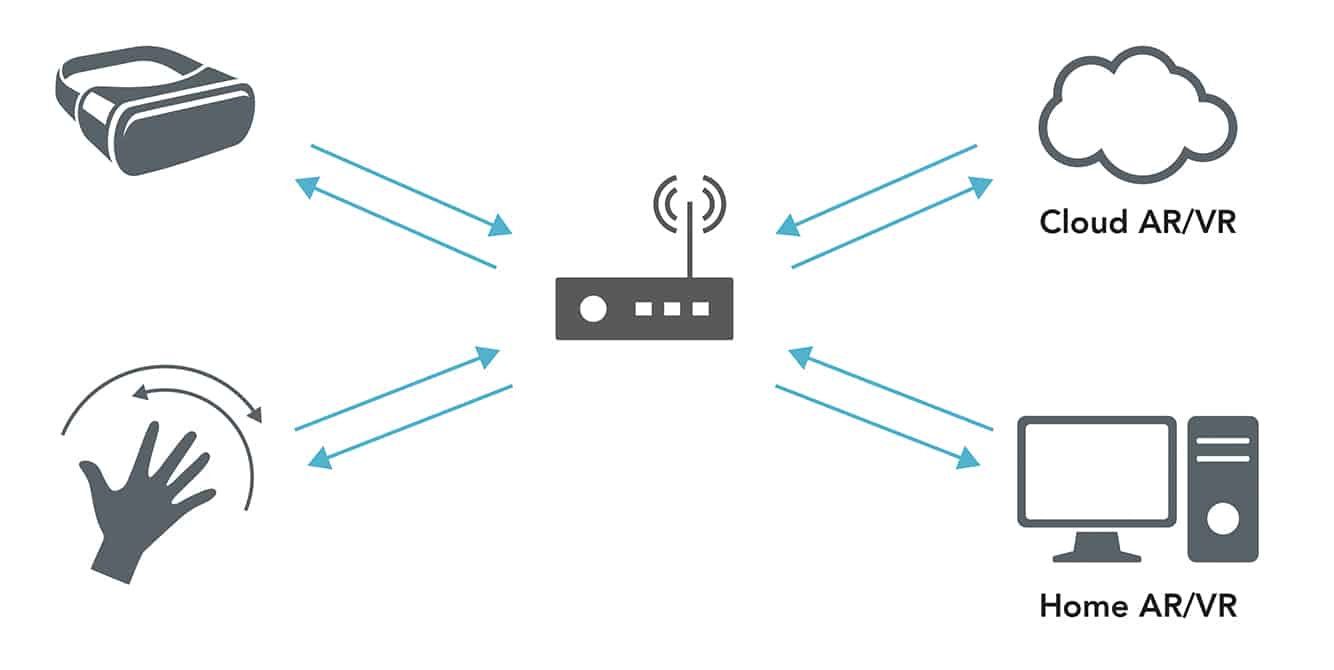
Figure 1: End to end latency
A look at Wi-Fi’s speed evolution
The IEEE’s 802.11be target performance of reaching a throughput of at least 30 Gbps may seem ambitious but looking back at Wi-Fi’s generational evolution of the past 20 years, the most striking progress is the pace at which the top data rates have increased. Thanks to a mix of technological advances and breakthrough new features, each generation has delivered higher performance than its predecessor.
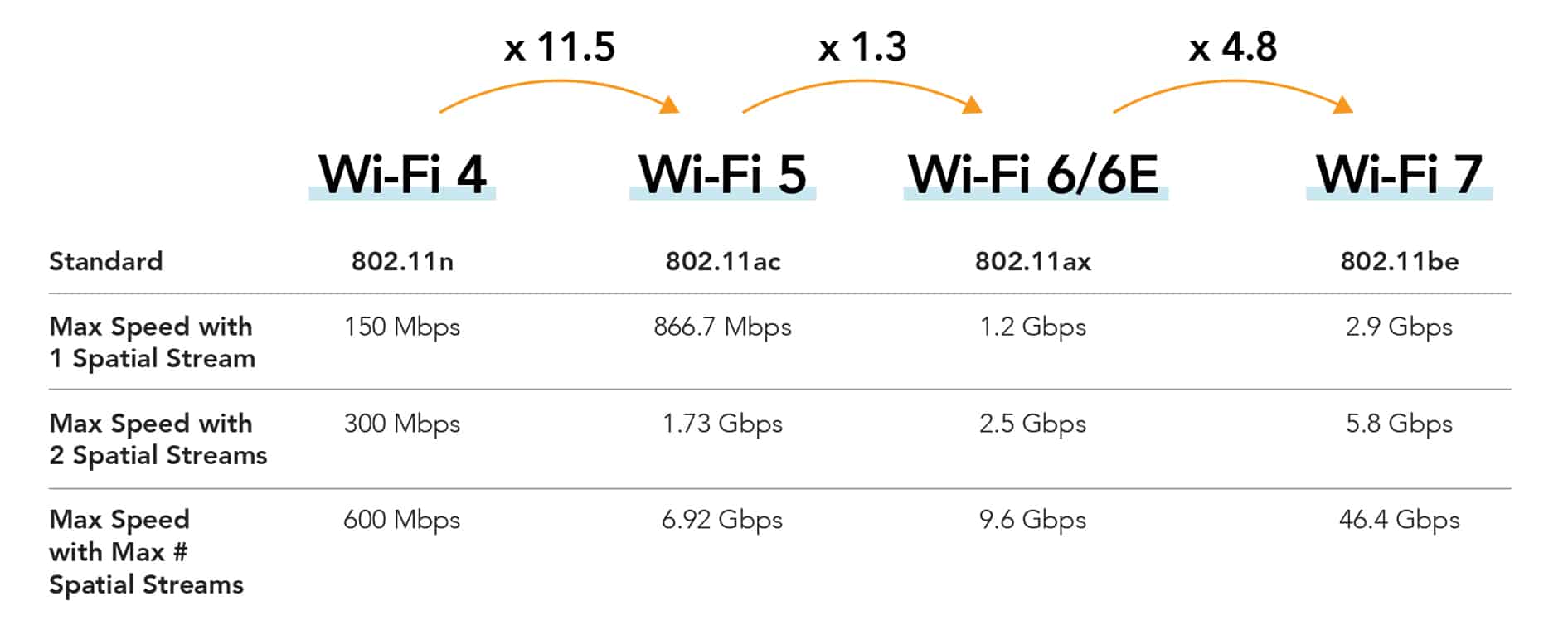
Figure 2: Wi-Fi generational speed evolution
The current generation of Wi-Fi 6 devices is based on the 802.11ax standard. At its inception, in 2014, the High Efficiency WLAN (HEW) 802.11ax standard was directed at improving spectrum efficiency and performance in dense networks. This goal was a departure from previous Wi-Fi generations that had mostly focused on throughput enhancements. Via innovative features most notably Uplink and Downlink OFDMA and MU-MIMO, in dense environments Wi-Fi 6 devices can achieve an average per-user throughput improvement of 4 times over Wi-Fi 5.
Furthermore, with the expansion of Wi-Fi in the 6 GHz band, Wi-Fi 6E devices can now benefit of up to 1200 MHz of uncongested spectrum. This additional spectrum opens the door to numerous new channels and enough contiguous spectrum to support the creation of extra wide 320 MHz channels. This is why, with the 802.11be standard, the focus is once again on delivering even higher throughput for Wi-Fi users with top speed up to 4.8 times faster than Wi-Fi 6/6E.
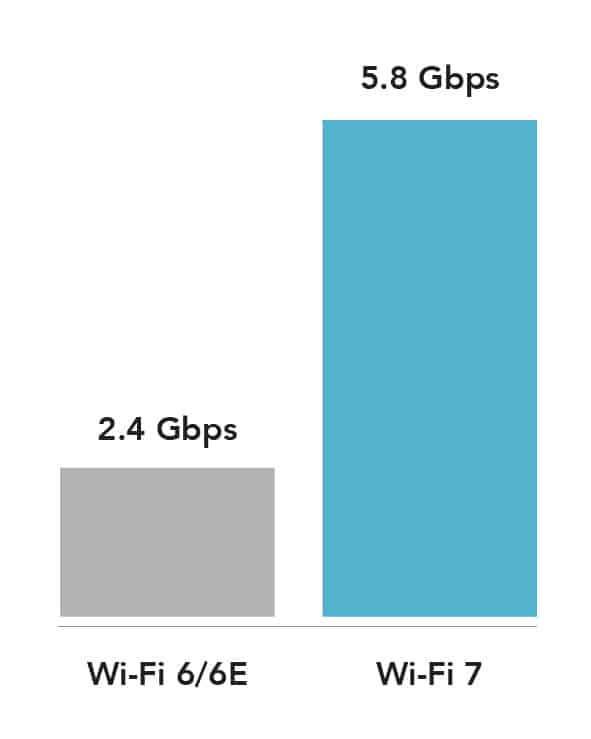
Figure 3: WiFi 6/6E and Wi-Fi 7 Speed Comparison for 2 Spatial Stream devices.
Wi-Fi 7 can reach a top link speed of 46 Gbps with 16 spatial streams and maximum 320 MHz channel bandwidth. For typical clients with 2 spatial streams, the highest data rate is around 5.8 Gbps on a single link, 2.5 times higher than similar 802.11ax clients.
What powers the Wi-Fi speed evolution?
Wi-Fi’s link speed evolution is powered by PHY technological enhancements along 3 dimensions:
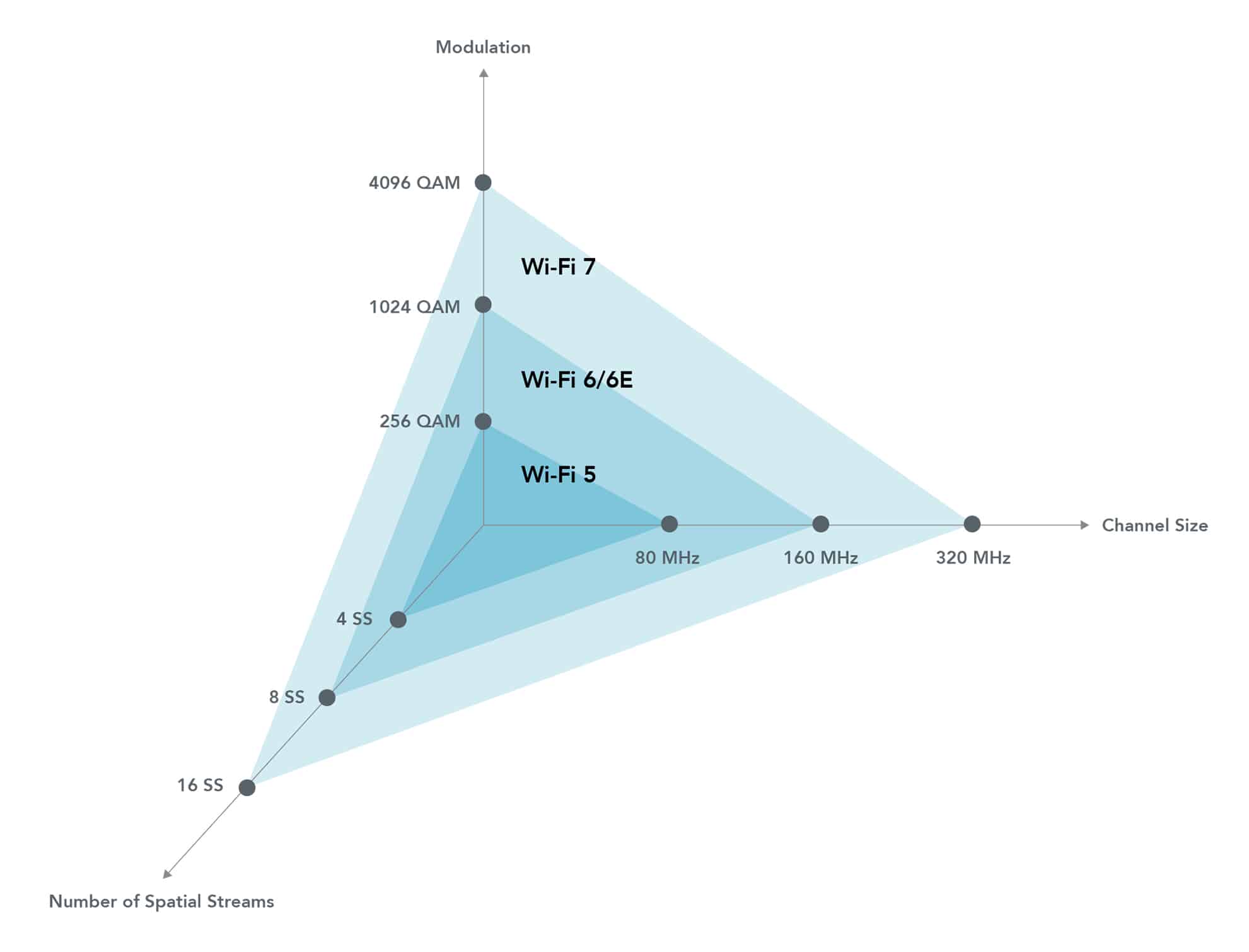
Figure 4: Wi-Fi PHY generational evolution
Modulation Order
Wi-Fi uses Quadrature Amplitude Modulation (QAM) for efficient data encoding. With each new Wi-Fi generation, higher data rates are achieved by encoding more data bits per symbol. Higher-order QAM enables to transmit more data bits while maintaining the same spectrum footprint and therefore achieve better efficiency.
4096-QAM leads to an increased data rate of 20% over 1024-QAM.
Channel Size
By doubling Wi-Fi’s channel bandwidth, nearly twice the amount of data can be carried in a single transmission. The 802.11be standard defines operation in the 6 GHz band, with a channel plan currently defined for up to 6 overlapping 320 MHz channels. The availability of 1200 MHz contiguous spectrum in the 6 GHz band has opened the door to doubling the channel bandwidth from 160 MHz (maximum bandwidth in 802.11ax) to 320 MHz channels, hence doubling the maximum throughput. Availability of the 6 GHz band is however subject to regulatory approval and not all worldwide regions can enjoy the same amount of spectrum. The 5 GHz and 2.4 GHz bands cannot support 320 MHz channels, therefore this Wi-Fi 7 feature will be accessible to only a subset of users.
Spatial Streams
Spatial streams increase the system’s throughput by transmitting independent data streams on multiple antennas simultaneously. Therefore, the maximum throughput of a system with 8 spatial streams is 8 times that of a system with a single antenna. The 802.11ax standard defined MIMO support up to 8 spatial streams and this capability is already supported by some AP chipsets. The 802.11be generation could support up to 16×16 in the future, and thus doubling the maximum throughput compared to 802.11ax. While the theoretical maximum throughput can only be achieved between devices with the same antenna count, the number of MIMO streams for Client Stations is typically limited to 2 or 3. The high number of spatial streams is an important factor for increased spectral efficiency with the implementation of Multi-User-MIMO (MU-MIMO), another feature supported in the 802.11be standard.
Multi-Link Operation
Multi-Link Operation (MLO), a breakthrough feature defined in the 802.11be standard adds a new dimension to Wi-Fi’s link speed evolution diagram.

Figure 5: 802.11be Multi-Link Operation
With a common MAC layer and separate PHY layers, Wi-Fi 7 Access Points and Client Stations are capable of transmitting and receiving simultaneously on multiple links. In the hypothetical case of an AP Multi-Link Device (MLD) operating at 320 MHz channel in the 6 GHz band and 160 MHz channel in the 5 GHz band connected to a dual-radio MLD Client (2×2 + 2×2), the throughput could reach up to 8.6 Gbps by having data transmitted simultaneously on both links and thereby reducing latency. By taking advantage of intelligent traffic scheduling and prioritization, MLO enables reduced latency(3) and jitter by prioritizing data transmission on links with the best RF conditions or improve reliability by duplicating data on multiple links.
Conclusion
While Wi-Fi 6 and Wi-Fi 6E high devices are well positioned for the needs of today’s applications, by the time Wi-Fi 7 reaches maturity it is anticipated that the consumer, enterprise, and industrial spaces will be upended with new applications requiring content delivery with extremely high throughput, low latency, low jitter and high reliability. The 802.11be standard is being defined to serve these applications so that Wi-Fi 7 can become the main connectivity technology capable of delivering the highest user experience. Wi-Fi device’s RF PHY performance is the critical foundation that will unlock this potential.
For more information visit the IQxel-MX page to learn about LitePoint’s test solutions for 802.11be or watch a replay of our webinar on Wi-Fi 7.
References:
1: https://standards.ieee.org/ieee/802.11be/7516/
2: https://www.qualcomm.com/media/documents/files/vr-and-ar-pushing-connectivity-limits.pdf
3: https://www.qualcomm.com/news/onq/2022/02/14/pushing-limits-wi-fi-performance-wi-fi-7
Wi-Fi 6/6E is a significant evolution of the Wi-Fi standard that boosts throughput and reduces latency to make it better for high-capacity applications as well as for emerging applications such as AR/VR, ultra-high definition video streaming, 5G offload and others.
These changes and the new opportunities they open up were the focus of a recent webinar hosted by RCR Wireless’ Catherine Sbeglia featuring LitePoint’s Adam Smith and Kevin Robinson from the Wi-Fi Alliance.
Wi-Fi 6 shipments have taken off surpassing 50% market share in terms of shipments in three years – a feat that took Wi-Fi 5 four years to achieve.
Wi-Fi 6 has a fundamentally different way of operating, using new technologies including orthogonal frequency division, multiple access (OFDMA) channel access method and 1024 QAM modulation to get this performance. With Wi-Fi 6E, the technology pushes into the 6GHz frequency band for the first time.
All of this sets the stage for understanding the new technologies that will impact the test strategies used to ensure the quality of Wi-Fi 6/6E products. Here are a few key points brought up by Adam during the webinar about the technologies and capabilities involved with Wi-Fi 6 and beyond:
With Wi-Fi 6E, systems need to support very wide spectrum – the 6 GHz band adds a total of 1.2GHz of additional spectrum over the 2.4 and 5 GHz bands. The RF front end will not be able to do this with a single filter bank or amplifier. This results in more complex RF front ends.
The other big factor with the RF front end will be band separation as the possibility exists that in a tri-band router that is transmitting in the 5GHz band could desensitize the receiver in the 6 GHz band.
The switch to OFDMA allows multi-user operation, enabling multiple users to transmit/receive simultaneously, making more efficient use of the channel. In Wi-Fi 6/6E, OFDMA allows the router to divide a channel into subchannels that can each support a user. This will require devices to have low frequency errors so as to not override a neighboring subchannel. Tight timing is also important to enable simultaneous transmissions so that all the client station devices respond to the access point within their allotted times.
And if that isn’t enough, Wi-Fi 7 is in the standards process and is offering all the efficiency of Wi-Fi 6/6E with extremely high throughput including 4096 QAM, 16 user streams and 320 MHz channels.
The full webinar discussion of the changes in Wi-Fi – including questions and answers – is available for replay and can be found here: State of Wi-Fi 6/6E
WiFi has become inextricable from daily life. But it hasn’t always been like that. Standards and adoption in the WiFi space today took years of research, iteration, and certification. While some key work has already been accomplished, there is still more that must be done for WiFi Sensing to continue along the road to standardization. But what exactly is it going to take for WiFi Sensing to become fully standardized and adopted in the mass-market? As ubiquitous as WiFi is for communications, so too will WiFi Sensing be for the modern home and beyond. But to pave the road for such a future, core standards must be developed to innovate and unify.
Standardized WiFi Sensing by 2024
The story of WiFi Sensing began about a decade ago with the publication of key academic research. Back then, utilizing WiFi signals for more than device communications was just a concept. This work was largely enabled by specialized research systems. With hardware too expensive to sell as a consumer WiFi product, WiFi Sensing remained largely in the academic space. Some work also began to utilize either unofficial third-party firmware patches or vendor-released research tools, which were specific to a small subset of consumer WiFi chipsets. During this time, it was difficult to get access to all the information necessary to develop a successful WiFi Sensing product.
To Each Vendor Their Own
To facilitate mass adoption of WiFi Sensing, there needs to be an effective transition from academic research to industry integration and application. Not only did it require proven commercial potential, key industry growth and scalability, it also needed to be a part of mainstream WiFi chipsets. But this big step from conceptualization to execution requires proven commercial potential and key industry partnerships for growth and scalability.
Cognitive was founded out of the desire to build a powerful but low-cost and easily scalable device that could leverage insights about changes in radiofrequency signals. That, however, would require us to design our own chip: the R10. The core advantage of the R10 was that it was mostly software-based in its interface with RF signals and so could be used for many different applications, simply by writing new software. By accessing channel state information not typically exposed in commercial chipsets, we were able to develop and refine our motion detection algorithms and build our consumer proof-of-concept product, Aura Home, the first solution of its kind in market which launched December 2017 and sold through Amazon. However, for the technology to be successful alongside pre-existing WiFi chips, we knew we would have to partner with key chipset companies like Qualcomm, Broadcom, Onsemi, and MaxLinear. But through this experience, it became apparent that without a standard, each vendor would implement things in a slightly different way, presenting a core challenge and requiring significant time and resources to design a technology capable of operating with all the different possible implementations. Standardization is important to enable vendor compliance and ensure compatibility among different vendors. Service and technology providers rely on utilizing a fixed set of features to efficiently and reliably provide their solutions. This is where WiFi Sensing standardization comes in, bringing all industry experts together to discuss and establish a baseline of key processes.
These efforts towards standardization will also have a noticeable positive impact on customers. With the development of new features and capabilities for WiFi Sensing, ISPs can deliver innovative consumer products to increase customer satisfaction through motion insights and analytics. Standardization is also extremely important to consumers because they want confidence that all the different products they purchase will simply work together and behave as expected. The 802.11bf standard is especially important for consumers as it opens up the possibility of endless potential applications in the home by using common devices instead of expensive, dedicated motion sensing hardware. WiFi is what it is today because there has been a standard or blueprint that describes exactly how anybody can build the components necessary to interact and function with the rest of the network. For WiFi Sensing to achieve its true market penetration potential, this blueprint needs to first be developed. Additionally, each product that receives the Wi-Fi logo and stamp must go through the certification program run by the Wi-Fi Alliance. Consumers look for that logo and stamp as a sign that the product not only has been designed with the IEEE 802.11 standard in mind, but has also gone through compliance testing.
How WiFi Motion is Leading the Journey
Innovation requires continuous, dedicated effort with the investment of key industry partners to see mass adoption and scalability — Cognitive’s WiFi Motion entered the market February 2020 as a camera-free home monitoring solution and is now available from 79 ISPs in over 65 countries. As WiFi Sensing continues along its journey, standardization will be the catalyst for endless new advanced features and services that redefine how the world uses WiFi. But the road doesn’t end there. WiFi Sensing needs companies like Cognitive with the technological, artificial intelligence, and algorithms expertise to create a robust network to provide faster adoption and greater accessibility. ISPs around the globe are already leveraging WiFi Motion to introduce their customers to the unlimited possibilities of WiFi Sensing. By joining WiFi Motion’s journey early, these companies are uniquely positioned to take advantage of new features as standards are developed. Only through collaboration will WiFi Sensing become a robust option for every wireless network and allow WiFi Motion to grow into a foundational ecosystem for WiFi Sensing.
The Road Ahead Is Clear: A Bright Future for WiFi Sensing
While the road to standardization can often seem nebulous, there are some key steps that aid the process in setting up a timeframe. The first step is to get interested people together to develop a standard. This was officially achieved when IEEE 802.11’s TGbf formed in October 2020. The next step is to develop the standard, which TGbf is currently working on, where the first draft is targeted to be released in March 2022. As per the IEEE process, the entire standard work being performed by TGbf is expected to be fully completed by September 2024. Once there is a written standard, a certification program is required to ensure all different vendor implementations are compliant with the standard. This will be completed by the Wi-Fi Alliance (WFA) as a parallel branch. Finally, it will take time for certified products to make their way into the hands of consumers, – but once they do, Cognitive’s technology will be ready to leverage the latest capabilities.
Through our involvement with these associations, we have gained a vast amount of knowledge as to what is necessary to build a successful sensing system. We also have a deeper understanding of some of the technological limitations that the current state of sensing presents. We want to continue to contribute to this field, encourage collaboration, and ultimately ensure there are tools available to help push the limits of WiFi even further in the future. Standardization is a naturally slow process but crucial for building a strong foundation for WiFi Sensing and future WiFi-based services. Cognitive wants to make sure that the standards being created not only have a complete feature set for modern challenges but are also positioned to gain widespread adoption in the future.
The Major Players in WiFi Sensing Standardization
The work towards standardization is ultimately a collaborative process only possible through the combined expertise of various organizations, companies, and individuals invested in the future of WiFi. There are three key players in this space: IEEE 802.11 Task Group bf (TGbf), the Wireless Broadband Alliance (WBA), and the Wi-Fi Alliance (WFA).
At the IEEE level, 802.11 is a group that owns, maintains, and develops the medium access control (MAC) and physical layer (PHY) specifications for WiFi. The MAC and PHY layer specs describe features, capabilities, and mechanisms that govern the operation of the lowest layers. Further, TGbf will produce an amendment to existing 802.11 standards that will ultimately build upon what already exists to enhance WiFi Sensing. It is important to understand that TGbF is an amendment, not a complete redesign of what already exists. In fact, within the scope of the TGbf project, there will not be any PHY layer changes or modifications for sub-7 GHz operation or descriptions. By utilizing IoT devices already connected to a home’s native network, a larger motion sensing coverage area can be created without requiring additional traditional security devices that might be more intrusive.
The WFA, on the other hand, works with specifications developed by the IEEE to create and test a certification program to ensure each implementation conforms to the standard. Components that pass all the defined tests and conform to the required standards receive the trademark WiFi logo and can be marketed and sold as such. The process of certification is extremely important as it quickly establishes trust with vendors, providing confidence that all due diligence has been performed. Specifically, for consumers, that means that they can feel confident in taking home a certain product that has passed specific levels of testing.
Finally, the WBA consists of a group of network operators and technology innovators who want to offer their customers seamless connectivity (i.e., allowing roaming between partner networks, billing exchanges, etc.). Utilizing their collective industry and research expertise, this group is focused on enhancing services, applications, connectivity, and customer experiences. Cognitive first got involved with the WBA when we were looking for the right platform to develop our technology that would benefit its members through various working groups. At the time, the WBA was the perfect fit, as they had a large network operator base and a number of technology providers. Together, we established the Wi-Fi Sensing Group, where we have been working to help not only introduce the technology, but also raise awareness of its current and future capabilities, and ultimately help with getting people ready for adoption. Part of the group’s work has also been helping publish Wi-Fi Sensing focused whitepapers, which highlights technological gaps that with standard support could further improve the technology. To date, the WBA has published three whitepapers in order to advance the field and stimulate critical thought around the technology. Topics include recommendations for early adoption of WiFi Sensing, how to evaluate a WiFi Sensing system, and factors that can impact the performance of a WiFi Sensing system (will be publicly available in spring 2020).

This collaboration enhances DOTS ability to deliver Wi-Fi based and privacy secure footfall data to their smart buildings, smart retail, airport and other transport hub verticals. In particular, the retail industry will benefit greatly from their new offerings with added data features such as the ability for shopping center management to understand and respond to peaks and flows in customer footfall more effectively and understanding important consumer behaviour. Features such as consumer dwell time, movement patterns and conversion rates in stores will help businesses to more accurately tailor their offering to encourage more visits, longer visits and ultimately more sales.
The partnership will bring Bumbee Labs into Middle Eastern territory for the first time, expanding their leadership from the European markets into further areas of the world. Already providing footfall data to some of the largest names in their home base of Sweden, such as Telia, Bluecom, IMAS, Springboard and CK Delta has inspired Bumbee Labs to explore and offer services to more diverse markets.
The physical retail industry is in dire need of additional data in order to be able to compete with online shopping. Bumbee Labs’ GDPR secure method can provide a number of important KPI’s using existing Wi-Fi installations, which reduces the need for additional hardware investments.
“We are excited to work with DOTS as our partnership in the UAE. Their innovation in delivering working solutions within smart city services (and the Internet of Things domain) will be merged with our expertise in providing anonymized data from smart phones to create an enhanced service that will accelerate the growth of the retail industry sector,” says Karl Samuelsson, the CEO of Bumbee Labs.
The CEO of DOTS Dheeraj Singh adds, “We are continually committed to delivering innovative and cutting-edge solutions for Smart Cities. As a pioneer in the space of Internet of Things (IoT) enabled Smart City applications, DOTS have a proven track record of delivering solutions that meet and exceed client’s expectations of digitization on the ground. We are very excited by this collaboration with Bumbee Labs as their data expertise will complement our IoT know-how providing an unparalleled service to our clients across several verticals, industries and markets in the Middle East.”
The partnership between Bumbee Labs and DOTS will enhance the retail industry of the Middle East by improving the accuracy of data collected from physical spaces. With this innovative collaboration, both companies expect to see a rise in ownership of sales from retailers again following a pause in growth during the last two years of the pandemic. The idea of monetizing Wi-Fi is now expanding to all markets around the world that want to stimulate the retail industry.

About Bumbee Labs
Bumbee Labs measures visitor flows by capturing anonymized Wi-Fi signals in smart phones and can do measurements in both outdoor and indoor environments. Visitor flows are measured anonymously, and the method is unique in being approved by a European Court of Law. Today, Bumbee Labs’ solutions also work outdoors in, for example, town centers. This is only the beginning of the digital alteration that we are working on to make towns and physical shopping even more effective and profitable. Discover more at www.bumbeelabs.com. Follow us on LinkedIn.
About DOTS
DOTS Tech Systems is a prestigious, Dubai-based smart solutions company whose mission is to develop cutting edge smart city technologies that deliver unbeatable, tailored IoT offerings for their customers. DOTS have solutions across numerous industries and verticals and within the context of the retail sector they are currently serving some of the best retail brands of the Middle East. Learn more at www.dotstechsystems.com. Follow us on LinkedIn.
Contact persons for further questions relating to the partnership:
DOTS:
Mohammad Foudeh, Sales Director, +97 155 2940707, mohammad@dotstechsystems.com
Bumbee Labs:
Karl Samuelsson, CEO, +46 707 588971, karl.samuelsson@bumbeelabs.se
For PR enquiries please contact:
DOTS:
Rebecca Lightbody, B2B Engagement & Digital Marketing, DOTS, rebecca@dotstechsystems.com
Bumbee Labs:
Amanda Herzog, Marketing Coordinator, Bumbee Labs, amanda.herzog@bumbeelabs.se
New Field-proven Sales Team to Fuel Expansion in Asia-Pacific (APAC)
SYDNEY and IRVINE, Calif., Feb, 16, 2022 – Morse Micro, a fabless semiconductor company reinventing Wi-Fi® for the Internet of Things (IoT), today announced it has expanded its presence In Asia and added three executive sales team members. Morse Micro Asia will support our local teams and customers across Asia’s growing economies including Taiwan, greater China, Korea and Japan.
The new executive team will focus on growing the company’s Wi-Fi CERTIFIED HaLow customer base in their respective markets, engaging and developing strategic Wi-Fi module and reference design partners, and expanding distribution channels, among other key activities.
“This is an important milestone in Morse Micro’s international growth and reflects the rate at which customers across the Asia-Pacific region are adopting Wi-Fi HaLow for a host of low-power, long-reach IoT applications,” said Michael De Nil, co-founder and chief executive officer at Morse Micro. “The collective breadth of experience of these new members to the Morse Micro team will help increase our customer base and market penetration in the strategic APAC region as we look to continue to grow our global presence as a market leader in innovative Wi-Fi CERTIFIED HaLow solutions.”
Key local team leaders:
Morse Micro’s comprehensive Wi-Fi HaLow portfolio includes the industry’s smallest, fastest and lowest power IEEE 802.11ah compliant SoCs. The MM6104 SoC supports 1, 2 and 4 MHz channel bandwidth. The higher performance MM6108 SoC supports 1, 2, 4 and 8 MHz bandwidth and is capable of delivering tens of Mbps throughput to support streaming HD video. These Wi-Fi HaLow SoCs provide 10x the range, 100x the area and 1000x the volume of traditional Wi-Fi solutions.
Using narrow frequency bands in the unlicensed sub-1 GHz spectrum outside the highly congested 2.4 GHz traditional Wi-Fi band, the IEEE 802.11ah based Wi-Fi HaLow signals penetrate obstacles more easily and can extend beyond 1 km, connecting far-flung IoT devices across residential, retail, office park, campus, warehouse and factory environments. Developed specifically for the IoT and supporting the latest enterprise grade WPA3 security, a single Wi-Fi HaLow access point (AP) can connect up to 8,191 devices, simplifying network deployment and reducing costs.
Morse Micro is sampling the smallest, fastest and lowest power Wi-Fi HaLow SoCs and modules for customer evaluation. Contact us today.
About Morse Micro
Morse Micro is a fast-growing fabless semiconductor company developing Wi-Fi HaLow solutions for the Internet of Things (IoT) market that can reach 10x the range of conventional Wi-Fi technology and last many years on a single battery. The company was founded by Wi-Fi pioneers and innovators, Michael De Nil and Andrew Terry, joined by the original Wi-Fi inventor Prof. Neil Weste and wireless industry veterans, whose teams designed Wi-Fi chips into billions of smartphones. Headquartered in Australia with offices in China, India and the U.S., Morse Micro’s strong and diverse system team, portfolio of IP and patents, enables Wi-Fi HaLow connectivity across the complete IoT ecosystem, from surveillance systems and access control to industrial automation and mobile devices, allowing connected devices to reach farther. www.morsemicro.com
Public Wi-Fi deployments are on the rise. Governments across the Worlds has realized the need for connectivity at every corner of the country that will provide opportunities to create new jobs, improve agricultural productivity, remote education and enhance local public services. In US, FCC’s have setup Emergency Connectivity Fund (ECF) and Rural Digital Opportunity Fund (RDOF) for $7.17 and $20.4 billion respectively that will guarantee higher internet speeds and will help schools and libraries to provide tools and services to their communities. Similarly, India announced PM-WANI scheme, aims to increase internet connectivity across the country by implementing a decentralized system of public access points to bridge the digital divide.
The challenges of deploying digital connectivity in rural and remote areas are not limited to just longer distances and rough terrain – the challenge is post deployment to operate and sustain the models to provide a reliable connectivity which decides the success or failure of these projects.
Aprecomm & HFCL joint Whitepaper explores these challenges faced and innovative measures to provide reliable connectivity in a rural-Wi-Fi deployments. In it we analyze:
Download the White Paper for more technical information & insights: “Reduced OpEx and Assured SLAs in public Wi-Fi Deployment through intelligent QoE measurement”

HFCL’s product portfolio includes WiFi 5 and WiFi 6 access points, point-to-point and point-to-multi point unlicensed band radios, L2 and L3 switches and specialised antennas which are designed, developed and manufactured in India keeping in view the global specifications
HCFL is among the largest suppliers of telecom equipment to telecom service providers, internet service providers and public sector units. (File Photo: Reuters)
NEW DELHI: HCFL on Tuesday signed a distribution agreement with Ingram Micro India Pvt. Ltd. for its ‘IO’ line of products.
HFCL’s product portfolio includes WiFi 5 and WiFi 6 access points, point-to-point and point-to-multi point unlicensed band radios, L2 and L3 switches and specialised antennas which are designed, developed and manufactured in India keeping in view the global specifications.
Ingram Micro is known for supporting and enhancing the reach of technology solutions for maximising adoption and consumption. It has an established network of more than 20,000 partners, 30 offices and 2,000 associates across the country.
“We are delighted to embark on the journey of our distribution network expansion with Ingram Micro India Private Limited, which has a stronghold in channel distribution in India and SAARC countries. The strategic goals of Ingram also align with ours, hence building the potential for greater synergies,” said Mahendra Nahata, managing director, HFCL.
HCFL is among the largest suppliers of telecom equipment to telecom service providers, internet service providers and public sector units.
“We are pleased to associate with HFCL as it is one of the fastest-growing Indian telecom companies. HFCL offers flexible, customised and reliable Make in India access solutions,” said Navneet Singh Bindra, vice president and chief country executive, Ingram Micro.

As the demand for 5G and Wi-Fi 6 continues to grow at a rapid pace and their standards become increasingly entwined, there has never been a better time to look at the possibility of convergence between the two technologies.
More than 18 billion devices in use, 4.4 billion shipping in 2022
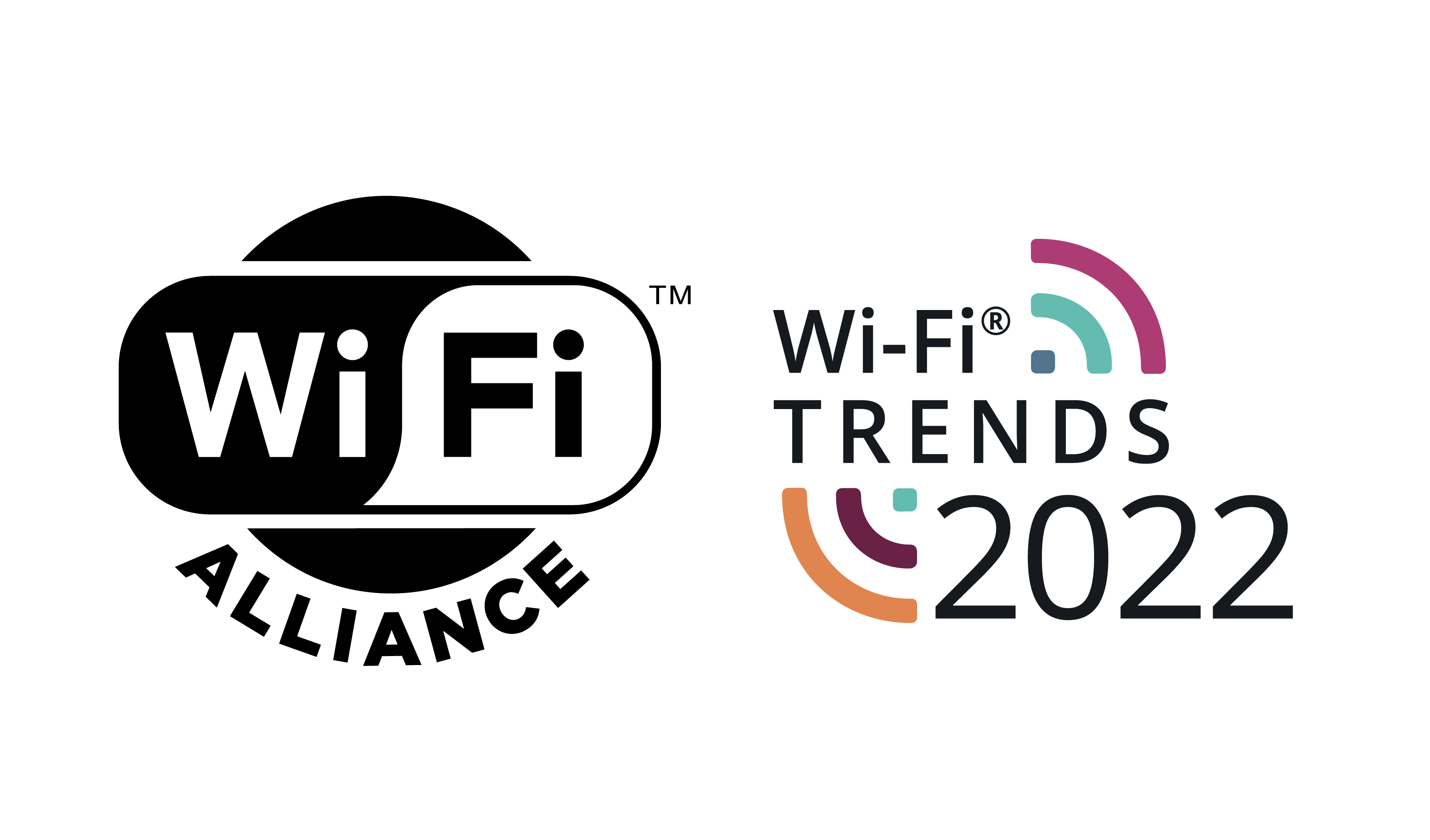
Austin, TX – January 20, 2022 – Wi-Fi® users demand more efficient, reliable, and secure connectivity in 2022. 6 GHz regulatory approvals, remote-hybrid work scenarios, and complex connectivity systems in home, enterprise, and Internet of Things (IoT) environments will only continue to drive demand for high capacity, low latency Wi-Fi. In 2022, nearly 18 billion Wi-Fi devices will be in use, and more than 4.4 billion devices will ship this year.1 As Wi-Fi momentum mounts, Wi-Fi Alliance® looks ahead at four Wi-Fi trends expected in 2022.
Wi-Fi 6 and Wi-Fi 6E further adoption in homes and enterprises
Wi-Fi 6 reached 50 percent market adoption more quickly than previous Wi-Fi generations, fueled by demand for high quality Wi-Fi and more efficient, reliable connectivity in phones, tablets, and access points (AP). Additionally, enhanced performance, low latency, and greater power efficiencies allow Wi-Fi 6 to satisfy diverse needs of IoT in unrivaled ways. Increasing availability of 6 GHz worldwide coupled with Wi-Fi 6E interoperability certification created the foundation for a diverse Wi-Fi 6E ecosystem, as more than 350 million Wi-Fi 6E devices will enter the market in 2022.2 In 2022, Wi-Fi 6 and Wi-Fi 6E will become more commonplace in daily life, both in homes and enterprises. Wi-Fi 6 and Wi-Fi 6E solutions for PCs and notebooks and mesh systems have already been introduced, and we expect many more home networking, automotive, IoT, and augmented/virtual reality (AR/VR) solutions supporting Wi-Fi 6 to make their way into users’ hands. Wi-Fi 6E access points will be deployed in home networks to meet the needs of bandwidth intensive, latency sensitive applications, and more service providers will recognize the tremendous speed and capacity benefits Wi-Fi 6E delivers to customers by making Wi-Fi 6E home gateways and access points part of their subscription plans.
Wi-Fi Alliance advances AFC framework
Global momentum for Wi-Fi 6E increases daily, and there is a sustained impetus to make the full 1200 MHz of spectrum in 6 GHz available for Wi-Fi in more countries. In 2022, Wi-Fi Alliance will continue to lead development of the Automated Frequency Coordination (AFC) framework to ensure a diverse ecosystem of AFC service providers necessary to maximize adoption of outdoor and standard power Wi-Fi 6E in regions requiring AFC. The AFC system, already adopted into the 6 GHz regulatory framework in Canada and U.S., is also being considered by regulators in other countries. Wi-Fi Alliance has already announced the release of specifications and test plans for AFC system implementation, and more than a dozen potential AFC service providers have expressed interest to the Federal Communications Commission. This year, expect Wi-Fi Alliance to continue to maximize the adoption of standard power and outdoor Wi-Fi 6E and accelerate delivery of Wi-Fi 6E benefits.
Wi-Fi meets diverse IoT requirements
The global smart home market will reach more than $53 billion in 20223, fueled by consumer desire for connected appliances, security systems, and smart speakers that help save energy, time, and money. As companies invest trillions of dollars in IoT and consumers add more connected devices to their homes, Wi-Fi will further transform the smart home market in 2022. Wi-Fi has long been the technology of choice for IoT, and an expanded Wi-Fi IoT portfolio can now better meet diverse smart home connectivity needs. Wi-Fi 6 reinforces Wi-Fi is a premier option for IoT; Wi-Fi 6 and Wi-Fi 6E include features such as orthogonal frequency division multiple access (OFDMA) that can improve performance in dense environments while target wake time (TWT) reduces battery consumption and makes Wi-Fi an ideal solution for sensor-based devices. Recently introduced Wi-Fi CERTIFIED HaLow™ delivers long range, low power Wi-Fi and enables a variety of new, power-efficient use cases for residential IoT and IIoT environments, as well as retail, agriculture, healthcare, smart home, and smart city markets. All Wi-Fi CERTIFIED™ devices require strong WPA3™ security, with the highest protections for IoT environments.
Wi-Fi networks reach new optimization levels
The growing number of devices and users relying on video conferencing, voice-over-IP services, X Reality (XR) applications, and high definition (UHD) streaming at home and in enterprise networks have placed additional strain on both network managers and service providers. The additional data traffic and advanced applications used on today’s Wi-Fi networks require a new level of network optimization. The Wi-Fi CERTIFIED portfolio of network optimization technologies has seen numerous advancements, resulting in Wi-Fi with greater mobility, enhanced network efficiency, and improved network visibility and management in home and enterprise networks in 2022. Optimizations including Wi-Fi CERTIFIED Easy Connect™ and Wi-Fi CERTIFIED EasyMesh™ now deliver more secure, smart, and efficient Wi-Fi home networks. Wi-Fi CERTIFIED Optimized Connectivity™ improves mobility when roaming within and across Wi-Fi networks and between Wi-Fi and cellular networks. Wi-Fi CERTIFIED QoS Management™ brings robust service delivery and high quality Wi-Fi experiences, while Wi-Fi CERTIFIED Data Elements™ helps service providers and network managers better manage complex Wi-Fi networks. In 2022 we will also see more Wi-Fi deployments by service providers in dense, city and public areas that support Wi-Fi CERTIFIED Passpoint®, a foundation of OpenRoaming framework, which raise the bar for speed, security, and reliability.
For more insight into 2022 Wi-Fi trends from Wi-Fi Alliance members, and to watch 2022 Wi-Fi trends videos from AirTies, Aruba, ASSIA, Boingo, Broadcom Inc., CommScope, Extreme Networks, HFCL Limited, Intel Corporation, NetExperience, onsemi, Qualcomm Technologies, Inc., please visit: https://bit.ly/2022WiFiTrends
1 IDC Research, 2022
2 IDC Research, 2022
3 Statista, 2021
About Wi-Fi Alliance® | www.wi-fi.org
Wi-Fi Alliance® is the worldwide network of companies that brings you Wi-Fi®. Members of our collaboration forum come together from across the Wi-Fi ecosystem with the shared vision to connect everyone and everything, everywhere, while providing the best possible user experience. Since 2000, Wi-Fi Alliance has completed more than 70,000 Wi-Fi certifications. The Wi-Fi CERTIFIED™ seal of approval designates products with proven interoperability, backward compatibility, and the highest industry-standard security protections in place. Today, Wi-Fi carries more than half of the internet’s traffic in an ever-expanding variety of applications. Wi-Fi Alliance continues to drive the adoption and evolution of Wi-Fi, which billions of people rely on every day.
Follow Wi-Fi Alliance:
wi-fi.org/beacon
wi-fi.org/signal
facebook.com/wificertified
twitter.com/wifialliance
linkedin.com/company/wi-fi-alliance
youtube.com/wifialliance